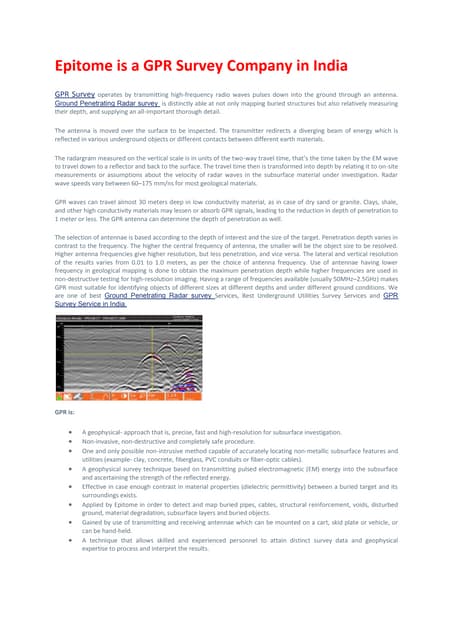Decrypting our Subsurface : GPR Investigations in Environmental Evaluation
Lately, the use of Ground Penetrating Radar, or Ground Penetrating Radar surveys, has emerged as a transformative tool in the field of environmental assessment and infrastructure development. This non-invasive technology enables experts to visualize and analyze what exists below the surface without the need for excessive excavation. As concerns about environmental sustainability and security grow, understanding the value and benefits of GPR techniques becomes crucial for experts across various sectors.
From identifying underground utilities to analyzing geotechnical conditions, Ground Penetrating Radar surveys have proven indispensable in making knowledgeable choices. They not only improve project efficiency but also help lessen risks associated with hidden subsurface conditions. As we delve deeper into the intricacies of GPR systems, its applications, and its role in today’s industry, we aim to provide a detailed overview for those seeking to utilize this effective tool in their projects.
##### Grasping GPR Investigations
Ground Penetrating Radar (GPR) is a non-destructive subsurface method which uses radio pulses to visualize the subsurface . https://output.jsbin.com/zubivuzexa/ elevated-frequency electromagnetic waves sent into the ground , that reflect off various underground substances. Through analyzing the reflected data, specialists can produce intricate images of the subsurface structures , including utilities , voids , and other irregularities. This technology is widely recognized for its ability to deliver real-time data and visualizations , making it an crucial tool in various fields such as construction, environmental assessment , and historical research.
A primary advantages of Ground Penetrating Radar investigations is their versatility . They can penetrate various types of soil and materials , from concrete and asphalt to rock and gravel. This flexibility enables comprehensive assessments in varied environments. Additionally, these surveys can function with minimal disruption to the surface , making them suitable for urban environments , construction sites , and delicate ecological areas . As a result , interested parties can gather vital subsurface information without significant disturbance to existing systems or ecosystems .
The significance of GPR investigations spans across multiple sectors, as they supply critical data for informed choices and project strategies. In construction and engineering , for instance , GPR can detect subsurface utilities and construction weaknesses , preventing expensive damage and delays during undertakings. In go to these guys , it assists in detecting contamination or changes in earth formations . Overall , this technology enhances the understanding of subsurface realities, enabling educated choices that enhance security and efficiency .
Benefits and Applications of GPR
Ground Penetrating Radar (GPR) offers multiple benefits, notably in the field of subsurface analysis. One of the main advantages is its non-intrusive design, allowing for in-depth imaging of the underground without disturbing the ground. This feature is crucially important in urban settings, where minimizing disruption is crucial. Additionally, GPR can provide instantaneous information, enabling faster decision-making and more efficient project planning. Its ability to find a range of materials, including metals, synthetics, and ground materials, enhances its adaptability in various investigative scenarios.
GPR is extensively utilized in multiple industries, with important applications in building and civil engineering. By identifying the presence of underground utilities, obstructions, and defects, GPR assists in minimizing risks linked to excavation and construction. This technology also plays a vital role in environmental assessments, providing insights into the makeup of soils and pollutants, which is essential for site remediation and land evaluation. Furthermore, its applications spread to the field of archaeology, where GPR helps uncover historical artifacts and understand historical structures without excavation.
The adoption of GPR technology in structural inspections is changing maintenance practices. By revealing structural issues such as cracks, voids, and deterioration beneath surfaces, GPR contributes to proactive maintenance and safety protocols. This capability not only enhances the durability of infrastructure but also contributes to public safety and financial control. As developments in GPR progress, its variety of applications is expected to increase, establishing it as a vital tool for many fields that rely on precise underground data.
Selecting and Carrying Out Ground Penetrating Radar Investigations
Selecting the right GPR survey provider is essential for ensuring precise and reliable results. When selecting a provider, consider their experience, equipment quality, and expertise in the specific field needed for your project. Reviewing past works and client testimonials can offer perspective into their capabilities. Engaging a company that understands the local legal environment and has experience with similar survey circumstances can further enhance the project's effectiveness.
Once you have chosen a GPR company, the following step involves planning the survey itself. This includes defining the survey area, assessing the site conditions, and clarifying the goals of the investigation. Collaboration with the investigation team is essential to establish the optimal survey strategy, such as layout and scan depth, to meet project goals. Tackling any logistical challenges upfront, such as access difficulties and site safety, will contribute to a smoother survey process.
The actual conduct of a GPR survey typically adheres to a structured methodology. It begins with a location visit to install and adjust the tools, followed by data collection where the GPR device is moved across the assigned area. The data is then processed and interpreted to reveal subsurface details. Frequent communication between the survey team and stakeholders ensures that any findings during the survey are noted and can impact ongoing or future work, reinforcing the overall value of GPR surveys in discovering critical information about the subsurface environment.
